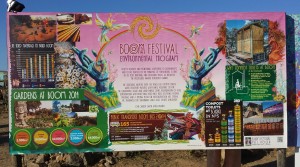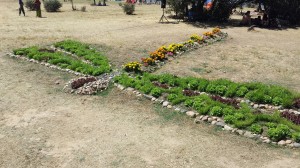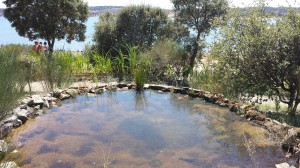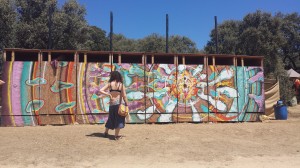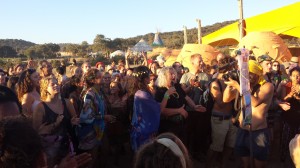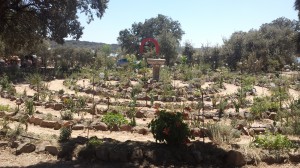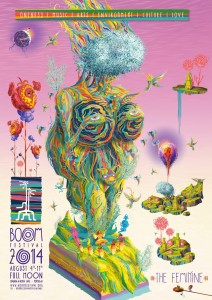“We all agreed that there is not a sufficient spiritual focus for the environmental movement. And without a spiritual focus, a movement like this doesn’t generate the kind of emotional energy that it needs to battle against global capitalism—that for which there is no other reality, according to most people. It should be a rallying call of the spirit for the environmental movement, or for as many parts of that movement as could be open to it.” –Hakim Bey
We are seeing festival culture move beyond being merely a hedonistic playground and into a realm where radical engagement can occur. A recent pilgrimage to Boom festival made this explicitly clear, where I witnessed a vibrant resurgence of psychedelic culture, a strong sense of oneness in a sea of global cultures, and a devout application of ecological principles.
We are currently living in a time where the imbalances between humans and the natural world are so staggering that most people are unknowingly participating in social, economic and political systems that perpetuate the destruction of Earth’s life support systems. We have been uninformed about the interrelatedness of our ecological crisis and the need to mend it from a holistic perspective.
It has been estimated that by 2100, half of all plant and animal species could become extinct. 90% of the large fish in the ocean are already gone. Thousands of acres of forests are disappearing daily. We are losing our planet.
Never before in Earth’s history has one species been the sole proprietor for the disappearance of so many other brilliant, beautiful forms of life. I embarked on an analysis of Boom’s application of ecological principles in hopes that it may hold a key to undoing this legacy of irresponsible behavior towards nature and shine a light on some deeply needed alternatives to our present situation.
Boom is a space where one can “rehearse for the future” according to André Soares, the director of Boom’s environmental program. André works as a permaculture designer at IPEC Ecocenter in Brasil (http://www.ecocentro.org/?lang=en). He conceptualized Boom’s water treatment system and spearheaded the festival’s transition to 100% compost toilets, the first festival to ever implement such groundbreaking and ecologically informed technology. His wife, Lucy Legan, designed all the permaculture gardens on site.
Let’s start with the basics: water. All the grey water at Boom, that stuff people shower with or use in sinks, travels to garden beds filled with aquatic plants that work to remove unwanted minerals by taking them up their roots and storing them in their leaves. This technique, dubbed bioremediation, represents a whole new way of utilizing our ecological knowledge to preserve and sustain the finite amount of fresh water that is available on our planet.
Techniques such as these are pioneering the way towards regenerative designs that can help reverse the mindless trend of wasting water. The filtration system, by default, creates a wetland ecosystem where native plants and birds in this beautiful Portuguese region can take up habitat. Here, using water means giving back to the community to support the beyond human inhabitants and create vitality on the festival grounds.
Boom’s energy is largely sourced from solar-power stations that power up most of the areas at the festival. The irrigation system for the gardens is running on a recently installed solar pump that draws water from the lake and brings it into a cistern where it can travel to 11 acres of Boom land. The land that the water reaches is filled with edibles such as lettuces, zucchini, cabbage, and strawberries, as well as many flowers and herbs that make up the gorgeous permaculture designs in the heart of this high desert region. People are encouraged to harvest food throughout the festival as they walk through the gardens.
In 2008, Boom launched a program titled “Your Oil is Music” where hundreds of tons of CO2 in the atmosphere avoided emission through putting waste vegetable oil in the generators instead of relying on fossil fuels. Boom’s environmental section on their website explores all of these initiatives in depth, with artful infographics to help visualize the ongoing application of these principles.
The compost toilets are waterless. Instead, they are filled with organic materials and nutrients such as carbon, which encourage biological matter to break down while neutralizing odor. The lids of the toilets automatically close when you leave the stall, ensuring that the heat stays in and pathogens die off. This is important because in two years, the contents of these compost toilets will become the soil that will grow food for people to eat while walking around the festival. Us Boomers are, quite literally, shitting where we eat. Of course the soil is tested before it is put back into the ground, and pathogens cannot survive outside of the body for more than 6 months anyway, so being grossed out by this process is failing to recognize the bigger picture. Millions of people in the world are without potable water so we don’t need to waste any more of it by flushing it down a toilet. Beyond that, the arable land on our planet is quickly vanishing due to irresponsible agricultural practices, so we urgently need to start building the soil back up again.
Techniques like this hold incredible promise for how humans can utilize naturally occurring biological processes to create fertile, healthy land. Also, traditional port-o-potty systems at festivals need to be shipped elsewhere when the festival is over. Here, all the contents stay on site, going back into the Earth to create viable land while reducing CO2 emissions and producing organic produce for years to come.
This all raises the question: What if entire cities were operating on these basic, life-affirming principles? How much could we avert further ecological catastrophe if we retrofitted civilization to reorient towards sustainable practices such as these?
I had the privilege of sitting down with renowned author, activist, and permaculture designer Starhawk after she led an unforgettable Spiral Dance outside of the Liminal Village at sunset. The Spiral Dance is an ancient tradition emphasizing community and rebirth, where participants sing in repetition while making fleeting yet profound eye contact with everyone they pass.
Seen from above, the Spiral Dance is a bunch of people linked together and moving in an ever-shifting spiral towards the center then back out again. Seen from below, the joyous expression of hundreds of wide-open eyes from all over the world engaged in meaningful ritual.
There were 152 countries represented at Boom this year. I am not sure how many of those 152 were participating in the Spiral Dance, but it felt incredibly powerful to see all of us transcending our own cultural and religious traditions to enact a greater collective expression.
After the Spiral Dance, Starhawk took a tour of the gardens on site, then we sat down together and I asked her what she thought about the designs on BOOM land.
“I like that things can stay here after the festival. There are gardens that can develop over time. I noticed mostly annuals so I’d like to see this land develop more perennial systems and food forests, systems that remain for years to come.”
I asked for insights on what it means to have an Earth Based Spirituality at a time of such great forgetfulness. An Earth Based Spirituality, she says, is
“Putting the Earth at the center of your spiritual practice, understanding that the Earth is sacred and the actual life support systems of the Earth are sacred…in the sense that they are really important, you know? We should be protecting them, we should be honoring them, and we shouldn’t be despoiling them. They are where you draw your sense of renewal and nourishment from, after all.”
Starhawk’s environmental work is connected to feminist spirituality, Goddess movements and paganism. Her role at Boom this year was especially symbolic because of this year’s theme, ‘The Feminine’, emphasizing the need to reconnect with cultures and ideas that honor and celebrate what it means to be female and to recognize the feminine aspects in all living beings and throughout nature.
Feminist schools of thought help to analyze how we got into the environmental mess that we’re now in. Movements such as Ecofeminism yolk together the feminist and the ecologist, believing that the attitudes that lead to the subordination of women are the same attitudes that lead to the destruction of nature. The term was first coined in 1974 by French feminist Francoise D’Eaubonne in her book Le Feminisme ou la Mort (Feminism or Death) and was expressed in the context of many protests against environmental destruction.
The witch-hunts in the beginning of our modern era was a time when many women (estimates range from 9 to 50 million) were captured, persecuted, tortured and killed because of their knowledge, wisdom, and close connection to nature. This period of intense violence towards women went on for roughly 300 years, unquestionably still permeates the collective unconscious, and was perhaps the start of our modern patriarchal ideals. This largely misunderstood part of history also represents some of the underpinnings as to why we, as a human species, have drifted so far apart from viewing the Earth as sacred and worth preserving.
Much of the decorum at Boom was feminine-inspired, consisting of paintings and sculptures representing the Goddess archetype. There was a whole day in the Liminal Village, Boom’s dynamic classroom, dedicated to, ‘Love, Pleasure and The Feminine’ where people could pay homage to ‘the Feminine energy manifesting as the principle of relatedness.’
Boom’s visionary digital aesthetic represented on their website and throughout their literature is filled with feminine characters of many kinds, including a colorful, psychedelic version of the Venus of Willendorf, a character based on one of the earliest Paleolithic sculptures denoting Goddess worship in early civilizations.
Next I sat down with another inspiring presenter, earthen builder and teacher, Janell Kapoor, to discuss bio-construction and its affect on the human psyche. With most structures on Boom land made from biological and recycled materials, I asked Janell what she thought about the festival architecture.
“The landscape and eco architecture is something that is forming the physic landscape at Boom. If Boom was built out of these square boxes (points to a trailer backstage), it would have a very different kind of presence on people’s experience then these gorgeous earthen, bamboo and other natural materials such as these tensile fabric structures. The sweet thing is…tensile structures, which are the lightweight, flexible fabrics blocking the sun in the structures here, are all based on natural geometry. It’s all built on what the universe is made of. This shape (points to a piece of tensile) is a shape that nature produces, it’s a shape that you see throughout nature based on mathematics. It’s found in our DNA, the planets, sunflowers, trees, etc. So, to have that reflected everywhere we go in this place, to be amongst shapes and forms and a geometry that is ‘us’ is also informing our experience here in a really beautiful way.”
She goes on to say, “as Earthlings, there’s this primordial connection with Earth, there’s also this cosmic connection with the Divine…and to have both of those reflected in the architecture of place here is speaking to us as Earthlings, and as Earthlings that are part of a planetary system, a galactic system, a cosmic system. It is something that is distinctly different then the majority of our built environments. Whether we know it or not, this is lifting our experience here and informing it very much.”
“Do you think that the environmental program at Boom is enough to change people’s attitudes and lifestyles towards the environment?” I asked.
“I think tours would be exciting, en masse, on a regular basis, certainly daily, if not twice a day. I imagine people would be interested in attending that. Also, more signage so that people could understand the story behind it. It’s one thing to do it, it’s another thing to share why it is happening, how it is happening, what is happening, where it’s coming from and what the story of this place is. I can imagine that the people who come here would be really interested in knowing this. I bet about half the people here, say 20,000, would be really curious. The other half are in total party zone. But this is an opportunity to really turn people on and it’s doing that subtlety by just being here and to do it more overtly through tours, more signs, through even more workshops and presentations about how things were built here would make for a great turnout.”
“How can the ecological principles we are witnessing here be practiced on a larger scale, say, in a city?”
“Each bioregion should assess what could be produced, what’s still missing, then design as though they didn’t have the ability to ship in from a distance. It’s interesting because people often react from a place of limitation when exposed to these ideas, meanwhile, its what we crave on a deep level. If we look at a place like New York and we start to assess how much could every school grow, church grow, how much rooftop space can we take up, and really produce food? How can we really do this? We take it to the furthest extent that we can. Obviously, a huge amount of remediation is necessary, but the technology is there, and if we can do what we’ve done on this planet with skyscrapers, rockets and the level of development technology wise, then we can certainly figure out how to clean our water and grow our food, I mean Jesus… This is the greatest invitation of our time. How do we, once again, learn how to be part of a living planet and literally be partners with this living planet that just keeps on living. Life hasn’t stopped here, we’ve just forgotten how to be part of it. And we have all the knowledge we need. We have all the solutions. I don’t think it’s about research. It’s about engaging in more of a clear vision, collectivizing that vision and moving in that direction. It’s a great invitation for re-orientation.”
Janell is launching regional earthen building movements in many parts of the world including Southeast Asia, South America and southeastern United States. She is the founder of Kleiwerks, (http://www.kleiwerks.org), an internationally acclaimed eco-urban demonstration site and living-learning laboratory in Asheville, North Carolina.
Next I sat down with Chiara Baldini, the coordinator of the Liminal Village. “How do you feel about the way Boom’s environmental program is received by people here?”
“It has always been Boom’s mission to provide information to deepen consciousness to become more aware. In this way, everyone is in a different state of evolution and you can get more or less depending on where you are in your development.”
Chiara continued telling me that the recycling program in this particular region of Portugal is non-existent, so they are hoping to make these practices common amongst the people that live in the neighboring area.
She mentioned how teams show up months before the festival to get the gardens going and construct the earthen buildings on site. It’s a pretty serious undertaking, one not for the faint of heart. Working in the blazing heat for months on end takes real endurance and dedication.
“This is a decentralized way of doing things,” Chiara explained, “Going against the system. We have to implement the technology to be independent from the system.”
Her comment reminded me of a thought I’ve been entertaining ever since I tried to crack the riddle as to how humans became so displaced here on planet Earth. If the commons are claimed and communities know that they have access to water and land again, there would be a shared sense of responsibility and a genuine desire to take care of the things that sustain life on this planet.
When we aren’t legally allowed to set up rainwater catchment tanks to reduce our water consumption, and we’re still living in a system where water is purchased in plastic bottles from very large corporations, we have a problem with the system working in direct opposition to giving communities autonomy over how they want their resources to be distributed and maintained. There has never been a better time for us to practice a reintegration of our awareness back into the natural systems on which we depend while continually challenging the concentrated powers that stand in the way of us being able to do so.
Reclaiming the commons goes beyond just resources, for it is also about taking back what it is that informs us, the media messages that capture our attention and inform our shared sense of values. This ties in closely with Boom’s commitment to be free from corporate sponsorship and logos, with 100% of their funds coming from ticket sales. This way, there is radical autonomy, the absence of ulterior corporate motives, and the ability to pursue innovative visions characterizing the emergence of a new social order.
Nobody gets to call the shots on how culture is expressed at Boom except those that participate in the making of it. At Boom, we can exist in free cultural spaces, or ‘Temporary Autonomous Zones’, a conceptual framework described by post-Anarchist writer and Sufi scholar Hakim Bey. A ‘Temporary Autonomous Zone’ is “a liberated area of land, time or imagination where one can be for something, not just against, and where new ways of being human together can be explored and experimented with,” As Andrew Boyd describes in his book, Beautiful Trouble: A Toolbox for Revolution. (http://beautifultrouble.org/)
Sparking a real social and environmental movement, something that is deeply needed at this moment in time, is possible if it is compelling enough for people to want to participate in. Weaving ecological principles into art and culture creates a participatory system where it becomes fun to do what’s right for the health of our planet.
“We can’t simply do less of a bad thing, we have to do a better thing, otherwise what’s the point of this experience if we’re not going to make things better?” André Soares explains.
Boom festival is a space to re-imagine what is possible for how a human society can function and thrive in close connection with living systems, with each other, and with novel ideas that are charting a new course for how we construct our reality. With permaculture gardens, cutting-edge filtration systems, renewable energy, compost toilets, and intelligent earthen buildings, Boom gives people an opportunity to reconnect with their biological origins and see themselves as co-creators of the great planetary unfolding. These are the spaces where we practice the new, moving beyond societal limitation and entering into the realm of radical possibility.

